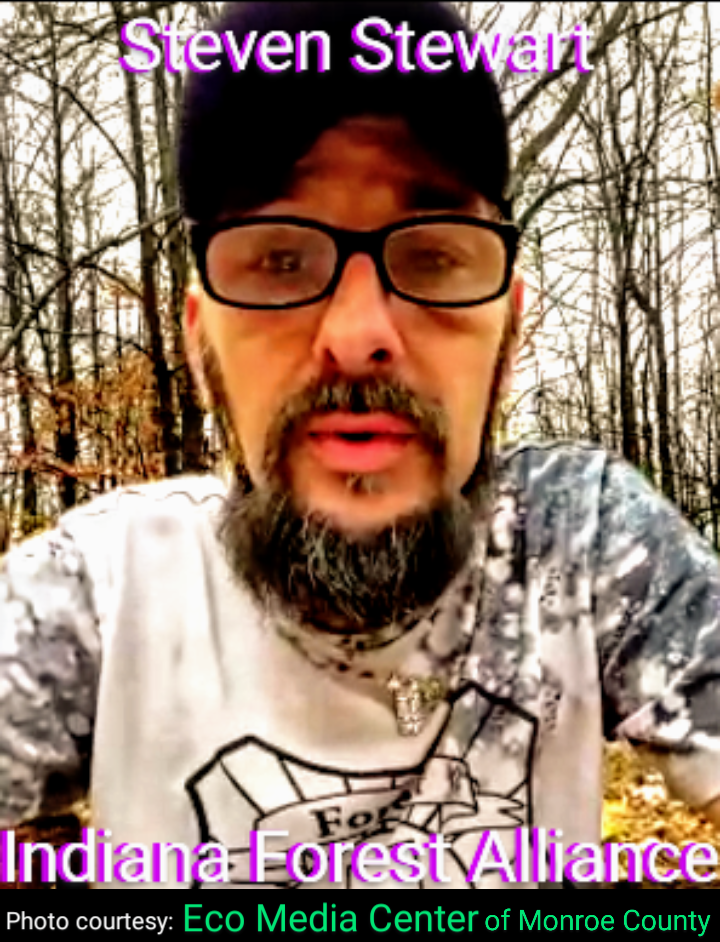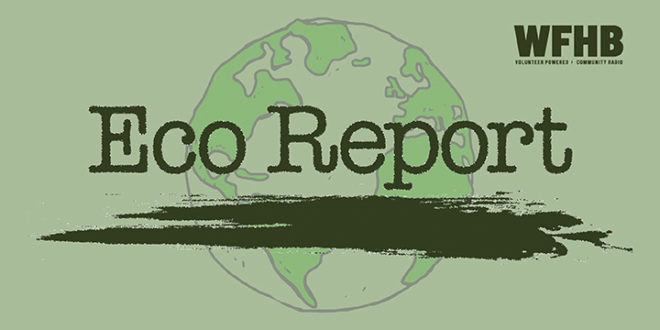Podcast: Play in new window | Download (Duration: 29:53 — 41.1MB)
Subscribe: RSS
Hello and welcome to Eco-Report. For WFHB, I’m Julianna Dailey. And I’m Frank Marshalek. Coming up later in this edition of Eco Report, Environmental Correspondent Zyro Roze gets an update from Steven Stewart of the Indiana Forest Alliance on a new attempt at prescribed burning and logging proposed for the Lake Monroe watershed.
And now for your environmental reports:
The Environmental Protection Agency (EPA) announced that the Indiana Department of Environmental Management (IDEM) has been selected to receive a $325,000 pollution prevention grant through President Biden’s Investing in America agenda. This is a key pillar of Bidenomics. The EPA has selected IDEM to receive the funding made possible by President Biden’s Bipartisan Infrastructure Law. The goal is to develop and adopt practices that prevent pollution at the source in local communities.
IDEM will use their grant funding to help small and medium-sized businesses in Indiana implement changes such as identifying and repairing compressor leaks and cleaning out barrels properly. They will provide training, peer mentoring, toolkits and environmental management systems planning. The project will help reduce the use of hazardous chemicals. “Preventing pollution is a crucial part of environmental justice efforts across the Great Lakes region,” said EPA Region 5 Administrator Debra Shore. “Thanks to the Bipartisan Infrastructure Law, the grants being announced will encourage businesses to help overburdened and underserved communities become cleaner, healthier places to live, learn and work.”
There is virtually no limit to opportunities for improvement. Indiana has 24,000 miles of rivers and streams that are sufficiently polluted that if you swim in these waters, you stand a good chance of getting sick. Indiana is “business friendly,” so its laws allow high levels of pollution.
—Norm Holy
The historic wildfire season currently plaguing Canada is expected to persist, a potentially devastating forecast made more likely due to human-caused climate change, according to new research. Drought and hot conditions contributed to an unprecedented start to the fire season in Canada and has kept the fires burning all over the country since late April says Kristina Dahl, senior climate scientist at the Union of Concerned Scientists.
Currently, more than 40 million total acres have been burned, an area nearly as large as the state of Georgia, according to the Canadian Interagency Forest Fire Centre. There are more than 1,000 active wildfires burning in Canada, with more than 650 of them deemed “out of control,” according to the agency. The fire season would not have gotten this bad were it not for anthropogenic, or human-caused, climate change, according to a new study released Tuesday by World Weather Attribution, an international group of academics and officials that evaluate the influence of climate change on extreme weather events.
The carbon dioxide level in the atmosphere increases every year. We will know we are making progress when the growth in carbon dioxide slows.
—Norm Holy
The Arctic National Wildlife Refuge in Alaska is one of the last intact, wild landscapes of its kind. It’s a sanctuary for a remarkable array of wildlife, from polar bears and awe-inspiring caribou herds to millions of migratory birds. In its final days, the Trump administration issued leases to drill for oil on the refuge’s fragile coastal plain where these animals live. But the Arctic is already heating up at a rate four times faster than the rest of the planet. The stakes for this incredibly vulnerable place couldn’t be higher.
The plans in place to halt global warming are inadequate. The globe is warming at an ever-increasing rate. Thus, we can expect much higher temperatures in the Arctic. The refuge may even become forested if we continue on our current path. Back when there was much greater volcanic activity, the carbon dioxide content in the air was over 1000 ppm, and there were forests and even alligators in the Arctic. While that degree of warming is not expected, the future Arctic will be vastly different than what it is today. Polar bears are likely to be extinct in the wild. Nonetheless, the area could become the only relatively cool place for species that require cooler temperatures.
For preserving many cold climate species, we will need to protect the Arctic Refuge. Arguably even more important will be protecting the Arctic Ocean from drilling and fishing. The cold water fish are already moving northward from both of our coasts. Even if we did everything possible to halt warming, this trend will continue through the lifetimes of everyone currently alive. But if large portions of the Arctic Ocean are maintained as a preserve, they will become really important for reestablishing populations along both the East and West coasts as the climate cools. While that may be thousands of years off, it is important to start now.
—Norm Holy
The New York Times reports that hidden within the seemingly barren expanse of White Sands National Park in New Mexico are human footprints. But these impressions are much more than random tracks: They are ancient vignettes cast in gypsum-rich sand. The footprints tell stories of hunters stalking a giant sloth; a traveler slipping in mud with a child on one hip; children jumping in puddles, splashing in play; and more.
But one question has plagued researchers studying these prints. Exactly how long ago were they made? A paper published in 2021 offered a somewhat surprising answer: Humans could have pressed their feet in the sand as early as 21,000 to 23,000 years ago, making the tracks some of the oldest evidence yet found of people in the Americas.
The result elicited both excitement and skepticism, with calls for additional tests to back up the astonishing claims. A new study published Thursday in the journal Science employed additional methods to determine the age of the tracks and adds to the evidence for those surprisingly ancient dates.
—Norm Holy
When is an area truly safe from exploitation? The answer seems to be NEVER. A few years ago, during the Trump era, there was a proposal to open a gold mine right next to the northern entrance to Yellowstone National Park. Environmentalists were concerned about this proposal from the very beginning. EcoReport covered the blow-by-blow battle. Concerns were about preserving animal life: for many species the area is part of their natural migration territory. Both Grizzlies and wolves frequent the target area.
Furthermore, the watershed includes the Yellowstone River and the concern was that the toxic runoff from a mine might poison the river. The battle was pitched for a couple of years. Finally, the environmental concerns won and there was no mine. Recently, there has been a new attempt to open this mine. The effort was halted because environmental groups raised six million dollars to buy enough land to make it unattractive to mine.
—Norm Holy
And now, we turn to Zyro Roze and his interview with Steven Stewart, Hoosier National Forest Program Director for the Indiana Forest Alliance, on how the Hous•ton-South project could affect endangered species, the health of County residents and the municipal drinking water supply for Bloomington.

| For Eco-Report, I am Julianna Dailey. And, I am Frank Marshalek. Are you looking for a way to make a difference on environmental issues? Here at EcoReport we are currently looking for reporters, engineers, and segment producers. Our goal is to report facts on how we’re all affected by global climate disruption and the ongoing assaults on our air, land and water. We also celebrate ecologists, tree huggers, soil builders and an assortment of champions who actively protect and restore our natural world, particularly those who are active in south central Indiana.
All levels of experience and all ages are welcome, and we provide the training you’ll need. W-F-H-B also offers internships. To volunteer for Eco-Report, give us a call at (812) 323-1200, or e-mail us at: [email protected]. |
|
And now for some upcoming events: Join the Uplands Network of the Sierra Club for a 7-mile hike on the Sycamore Loop Trail in the Hoosier National Forest on Saturday, October 28th, from 9 am to 1:30 pm. There will be a stop for lunch while you enjoy the beautiful fall foliage. Register at [email protected] or call 812-320-9322. |
| Take a Spooky Full Moon Hike on Saturday, October 28th, from 9:30 to 11 pm at Leonard Springs Nature Park. During the hike you will learn the history and folklore surrounding the full moon and Hallow’s Eve. Register at bloomington.IN.gov/parks. |
| Celebrate Halloween with a Snake Meet and Greet at Brown County State Park on Tuesday, October 31st, from 3 to 3:30 pm. Get a close and personal look at one of Indiana’s native snakes. Learn their unique traits, their threats and how they affect your life. You will have the opportunity to pet the snake at the end of the program. |
| Take an Introduction to Hydroponics class at the Allison-Jukebox Community Center on Saturday, November 4th, from 5 to 6:30 pm. Learn an alternative way of gardening using water rather than soil. Register at bloomington.IN.gov/parks. |
| There will be a Night Owl Hike at Griffy Lake Nature Preserve on Saturday, November 4th, from 9 to 10:30 pm. A naturalist will accompany you as you learn how to spot and listen for common Indiana owl species. Meet at the boathouse. Register at bloomington.IN.gov/parks. |
| And that wraps up our show for this week. Eco Report is brought to you in part by M-P-I Solar, a Bloomington business specializing in solar hot water, solar electricity and solar hot air systems. M-P-I Solar designs and installs solar power generation systems that encourage independence and individual responsibility. Found locally at 812-334-4003 and on the Web at MPIsolarenergy.com. |
| This week’s headlines were written by Norm Holy. Today’s news feature was produced by Zyro Roze and edited by Noelle Herhusky-Schneider. Julianna Dailey assembled the script which was edited by Zyro Roze. Julianna Dailey compiled our events calendar. Kade Young and Noelle Herhusky-Schneider produced today’s show. Branden Blewett is our engineer. For WFHB, I’m Julianna Dailey. And I’m Frank Marshalek. And this is Eco Report! |
 WFHB Bloomington Community Radio
WFHB Bloomington Community Radio


